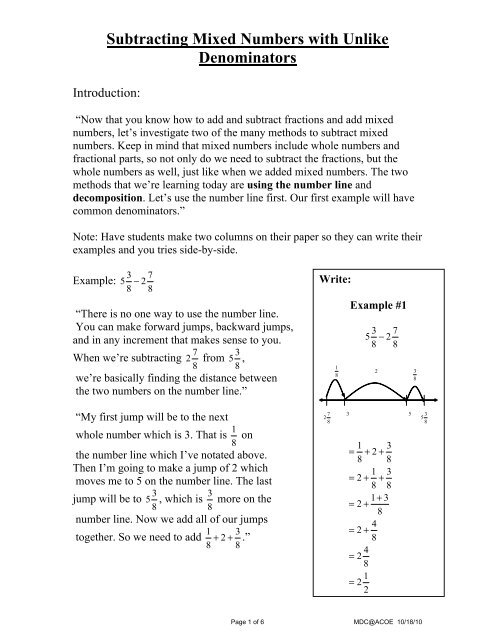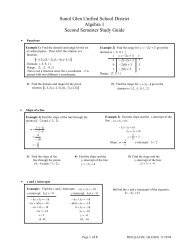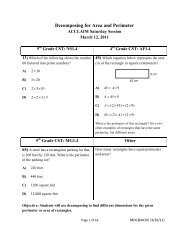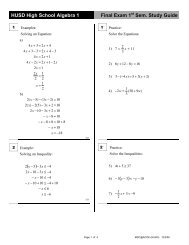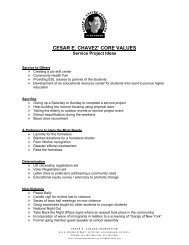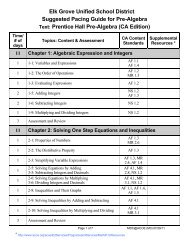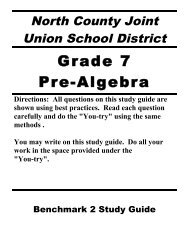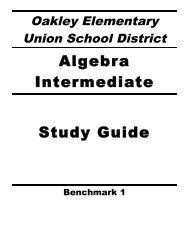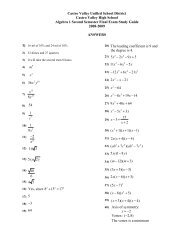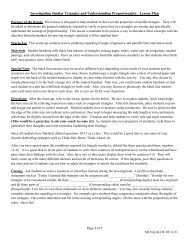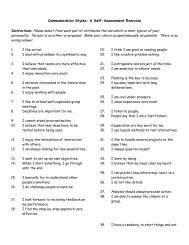Subtracting Mixed Numbers with Unlike Denominators
Subtracting Mixed Numbers with Unlike Denominators
Subtracting Mixed Numbers with Unlike Denominators
- No tags were found...
You also want an ePaper? Increase the reach of your titles
YUMPU automatically turns print PDFs into web optimized ePapers that Google loves.
<strong>Subtracting</strong> <strong>Mixed</strong> <strong>Numbers</strong> <strong>with</strong> <strong>Unlike</strong><strong>Denominators</strong>Introduction:“Now that you know how to add and subtract fractions and add mixednumbers, let’s investigate two of the many methods to subtract mixednumbers. Keep in mind that mixed numbers include whole numbers andfractional parts, so not only do we need to subtract the fractions, but thewhole numbers as well, just like when we added mixed numbers. The twomethods that we’re learning today are using the number line anddecomposition. Let’s use the number line first. Our first example will havecommon denominators.”Note: Have students make two columns on their paper so they can write theirexamples and you tries side-by-side.Example:“There is no one way to use the number line.You can make forward jumps, backward jumps,and in any increment that makes sense to you.When we’re subtracting from ,we’re basically finding the distance betweenthe two numbers on the number line.”Write:Example #1“My first jump will be to the nextwhole number which is 3. That isonthe number line which I’ve notated above.Then I’m going to make a jump of 2 whichmoves me to 5 on the number line. The lastjump will be to , which is more on thenumber line. Now we add all of our jumpstogether. So we need to add .”Page 1 of 6 MDC@ACOE 10/18/10
“Our fractions already have common denominators so we can add ourfractions together, along <strong>with</strong> our wholes. Soyou agree.”. Thumbs up, if[There should be some thumbs down because the answer is not in simplestform.]“Turn to your table partner and tell them why we aren’t finished. Who cantell me what I need to do?”[Put the answer in simplest form.]Write:“What is in simplest form?” [ ]Example #1“Now let’s do that same problemusing decomposition. First, I’m going tobreak apart the mixed numbers into a sumof its wholes and fractional parts.Because I am subtracting the entire quantityof, I must distribute the negativeor take the opposite of both terms insidethe parentheses. So the opposite of + is - ,and the opposite of + is - . Now I willrearrange my numbers so the whole numbersare together, as well as the fractions. I cansubtract my wholes, but I can’t subtract myfractions <strong>with</strong>out ending up <strong>with</strong> a negativefraction. So I’ll decompose into andfind an equivalent fraction for , which is .Now we have which equals .”“Can we subtract the fractions now?” [yes]“What is ?” [ ] “What is in simplest form?” [ ]Page 2 of 6 MDC@ACOE 10/18/10
“We arrive at the same answer of. One of the great things aboutdecomposition is that everyone does not have to decompose the same way,but we can all arrive at the correct answer!”“Let’s try another example <strong>with</strong> unlike denominators.”Example :“Again, on the number line, we arecalculating the distance betweenandWrite:Example #2. As I mentioned before, you can makebackward jumps as well. So I’m going tomove backward on this example. My firstjump will be fromto . That is a jumpof . Then I’m going to jump from to ,which is a movement of. Now I simplyneed to add and .”“What is the LCM of and ?” [ ]“What do I need to multiply by toget an equivalent fraction <strong>with</strong> adenominator of ?” [ ]“What do I need to multiplyby to get an equivalent fraction <strong>with</strong> adenominator of ?” [ ]“Now I can add my fractions. equals?” [ ]“Isin simplest form?” [yes]Page 3 of 6 MDC@ACOE 10/18/10
“How do you know? Turn to your table partner to discuss.” [becausethey have no common factors besides .]“Now let’s try the same example using decomposition. You should write itnext to the number line example we just did. Again, I’m going to break apartthe mixed numbers into a sum of its parts. I’m subtracting the wholequantity of and .”Write:“So what do I need to do next?”[distribute the negative or take the oppositeof both terms in the parentheses].“I rearrange my terms so I have mywholes together and my fractions togetherI can subtract my wholes, and I end up<strong>with</strong> . This time I’m going to decomposedifferently than the first example. Since Ineed to subtract, I’m going to decomposeExample #2into . Now we have whichequals so I can cross it out. Now we’releft <strong>with</strong> . Again, I need to makeequivalent fractions of and <strong>with</strong> anew denominator of .”1 1“What should I multiply by?” [ ]“What should I multiply by?” [ ]“Now that there is a common denominator, the fractions can be added. Thesum of is?” [ ]“You are all going to do the next example <strong>with</strong> your table partner. You willwork through the problem together, but each of you must write it in yourown notebook. Please do both strategies side-by-side. Once you’re finished,you’ll show it to me and get a piece of chart paper to chart your work. Onceeveryone is done, we will do a gallery walk to see how each pair solved theproblem.”Page 4 of 6 MDC@ACOE 10/18/10
“Is there anyone who doesn’t understand the directions?” [no (hopefully!)]Here is the problem:As time allows, have students who solved it differently explain theirthinking to the class.The teacher can also put up a chart once students finish. Try to decompose itdifferently than the students. Here is an example.You Try:Number LineDecomposition1 11 1Page 5 of 6 MDC@ACOE 10/18/10
Here is an additional you try that can be used as an exit card. You can alsouse it <strong>with</strong>in the lesson, if necessary. It is to be done independently so youcan see if the students have grasped the concept.You Try:Possible SolutionsNumber LineDecomposition111Page 6 of 6 MDC@ACOE 10/18/10


